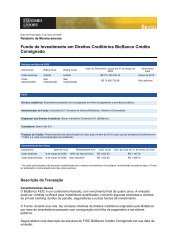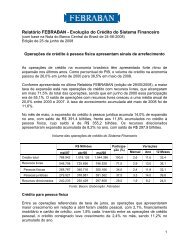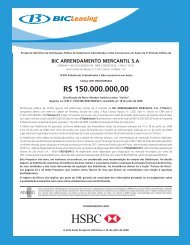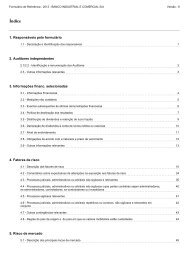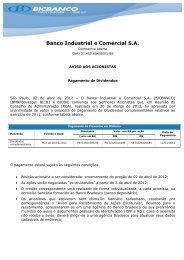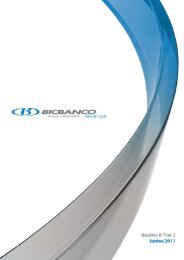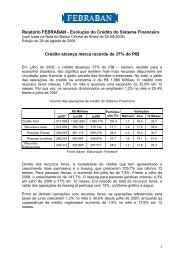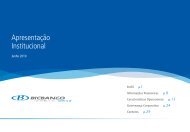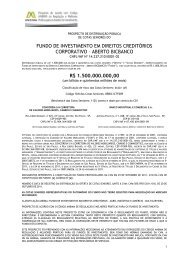HSBC J.P. Morgan Standard Chartered Bank - bicbanco
HSBC J.P. Morgan Standard Chartered Bank - bicbanco
HSBC J.P. Morgan Standard Chartered Bank - bicbanco
You also want an ePaper? Increase the reach of your titles
YUMPU automatically turns print PDFs into web optimized ePapers that Google loves.
The profile of the <strong>Bank</strong>’s lending portfolio may suffer due to a decline in Brazilian or international economic<br />
conditions.<br />
The <strong>Bank</strong>’s lending portfolio was R$9,119.2 million as of December 31, 2009, compared to R$8,066.4<br />
million as of December 31, 2008 and R$7,617.9 million as of December 31, 2007, in each case including only those<br />
CCBs which were retained in its lending portfolio and excluding contingent obligations. As of December 31, 2009,<br />
the <strong>Bank</strong>’s allowance for loan losses was R$418.8 million, representing 4.6% of its total lending portfolio. As of<br />
December 31, 2008, the <strong>Bank</strong>’s allowance for loan losses was R$310.9 million, representing 3.9% of its total<br />
lending portfolio, compared to R$133.4 million as of December 31, 2007, representing 1.8% of its total lending<br />
portfolio. The quality of the <strong>Bank</strong>’s lending portfolio is dependent on domestic and, to a lesser extent, international<br />
economic conditions. The increase of allowance for loan losses was due to the <strong>Bank</strong>’s decision to make additional<br />
provisions during the period due to the <strong>Bank</strong>’s perception of the negative impact of the global financial crisis on the<br />
Brazilian economy and in some of its clients’ financial conditions in the period. The <strong>Bank</strong> lends domestically in<br />
Brazilian currency mainly to corporate and middle-market borrowers in the commercial, services and industrial<br />
sectors. The ten largest customers of the <strong>Bank</strong> had loans outstanding in the amount of R$813.7 million and<br />
accounted for 42.0% of the <strong>Bank</strong>’s referential equity value as of December 31, 2009. Adverse changes affecting any<br />
of the sectors or individual borrowers to which the <strong>Bank</strong> has significant lending exposure, political events within<br />
and external to Brazil or the variability of economic activity may have an adverse impact on the <strong>Bank</strong>.<br />
Mismatches in the <strong>Bank</strong>’s credit portfolio compared to its sources of funding may adversely affect the <strong>Bank</strong>’s<br />
operating results and the <strong>Bank</strong>’s ability to expand its credit operations.<br />
The <strong>Bank</strong> is exposed to some mismatches between its credit portfolio and obligations in relation to interest<br />
rates and maturities. Mismatches between the maturity of the <strong>Bank</strong>’s credit portfolio and its sources of funding<br />
would increase the probability of imbalances related to interest rates, which also represents a liquidity risk if the<br />
<strong>Bank</strong> is not able to obtain funding to meet its obligations and operational needs. An increase in the cost of funds<br />
may increase the interest rates on the <strong>Bank</strong>’s loans, which may, as a result, affect the <strong>Bank</strong>’s ability to attract new<br />
customers. If the <strong>Bank</strong> fails to attract new borrowers or if the <strong>Bank</strong>’s costs of funds increase and the <strong>Bank</strong> cannot<br />
pass along these increases to its borrowers, the <strong>Bank</strong>’s operating results and financial condition could be materially<br />
adversely affected.<br />
Problems in raising funds may negatively affect the <strong>Bank</strong>’s operating results.<br />
The structure that the <strong>Bank</strong> has adopted to raise funds involves raising funds in the domestic and<br />
international capital markets. An international liquidity crisis could increase the costs of raising funds in foreign<br />
currencies, which would negatively affect the results of the <strong>Bank</strong>’s operations. Moreover, there can be no assurance<br />
that time deposits in the local market will continue to remain available under favorable conditions. In the event that<br />
the <strong>Bank</strong> is not able to raise new funds, it may not be able to increase the volume of its credit portfolio or to<br />
efficiently respond to changes in business conditions and competitive pressures, which may adversely affect the<br />
<strong>Bank</strong>’s business, financial condition and operating results.<br />
A reduction of the <strong>Bank</strong>’s credit rating may increase its borrowing costs, which may negatively affect the <strong>Bank</strong>’s<br />
operating results.<br />
The <strong>Bank</strong>’s borrowing costs depend on several factors, including some factors beyond its control, such as<br />
macroeconomic conditions and the regulatory environment for banks in Brazil. Any unfavorable change in these<br />
factors may negatively affect the <strong>Bank</strong>’s credit rating. An adverse impact in the <strong>Bank</strong>’s credit rating may limit the<br />
<strong>Bank</strong>’s ability to borrow funds or issue securities under favorable conditions, thereby increasing its borrowing costs.<br />
The factors and contingencies that may affect the <strong>Bank</strong>’s borrowing costs are frequently the same ones that may lead<br />
it to raise additional capital.<br />
If the <strong>Bank</strong>’s credit ratings were to be adversely affected, the <strong>Bank</strong> might be unable to obtain funding on<br />
acceptable terms, if at all, on occasions where it requires additional funding.<br />
AMR-248898-v2<br />
- 22 -<br />
95-40469277



